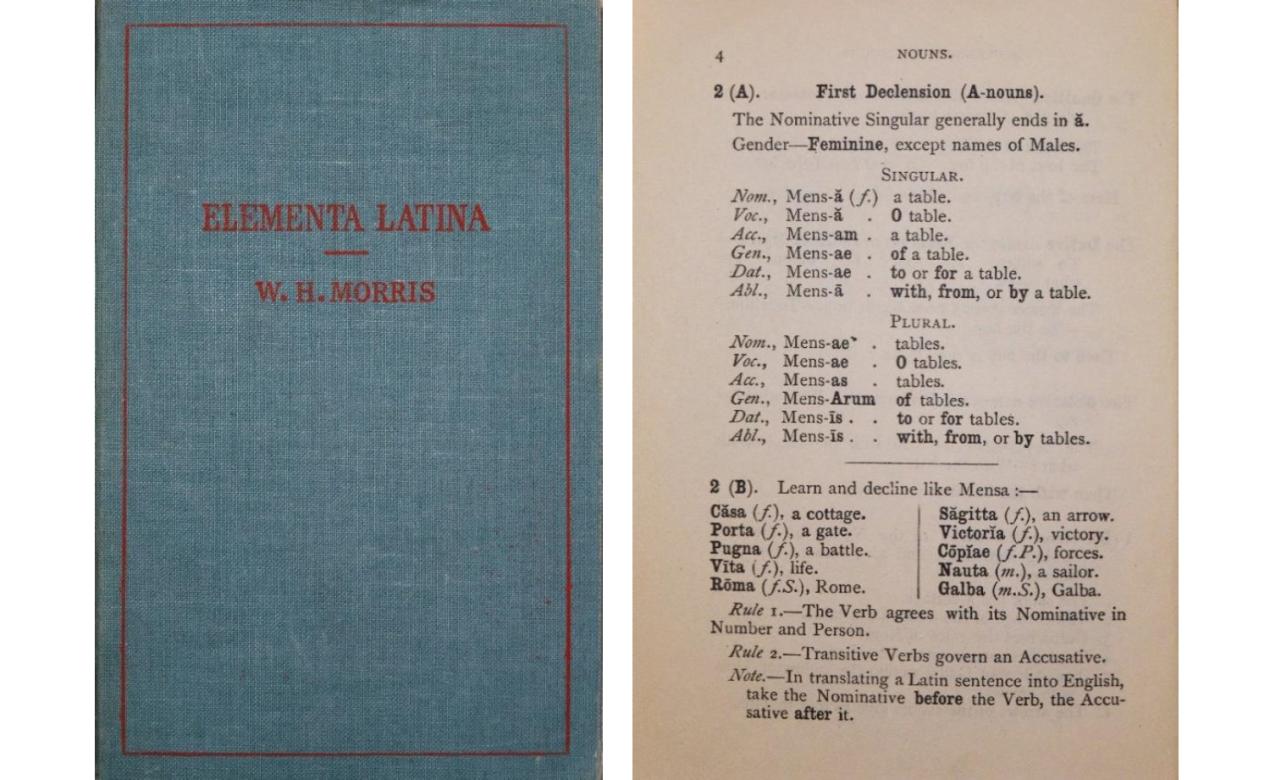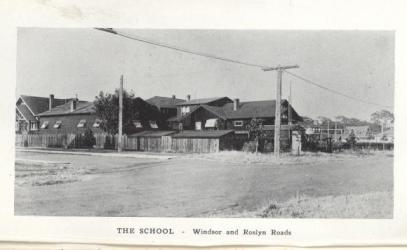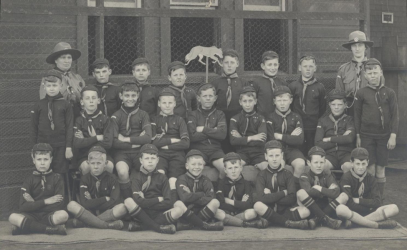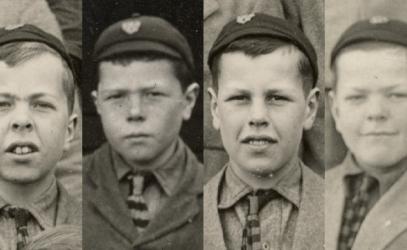
One of our Jubilee year projects is "Waiting to Be Remembered - Stories from St. Michael's School," a collection of incredible stories of connection and coincidence involving St. Michael's School Old Boys, researched and authored by Michael Nation (SMS '70).
Between January and June 2022, we will release stories by Michael Nation and we hope you will enjoy reading them.
Boys were taught a wide range of subjects during their years at St. Michael’s School. These are recorded in the early roll books which included, as well as daily attendance, marks for weekly tests, and every boy’s placing in his class for each term and for the year.
While the list of the subjects themselves remained quite similar over the decades, the content must have changed at least a little as theories and practices in education evolved. For example, I remember the introduction of “New Math” in about 1964. And Canadian and British history were taught in earlier decades, while the history period for the senior forms was renamed Social Studies in later years.
The subjects recorded in the roll books are given in the table below:
| SUBJECT | 1921 (Forms 4 & 3) |
1936 (Forms 4A, 4B) |
1948 Forms 4A, 4B |
1962 (Form 4A) |
|
| Arithmetic | ü | ü | ü | ü | |
| Algebra | ü | ü | ü | ü | |
| Geometry | ü | ü | ü | ü | |
| French | ü | ü | ü | ü | |
| Latin | ü | ü | ü | ü | |
| History & geography | ü | ü | ü | ||
| British history | ü | ||||
| Canadian history | ü | ||||
| Social studies | ü | ü | |||
| Grammar | ü | ü | ü | ||
| Reading | ü | ü | |||
| Writing | ü | ü | ü | ü | |
| Spelling | ü | ü | ü | ||
| Composition | ü | ü | ü | ü | |
| Literature | ü | ü | ü | ü | |
| Repetition | ü | ü | ü | ||
| Science | ü | ü | ü | ||
| General Knowledge | ü | ||||
| Drawing | ü | ü | ü | ||
| Health | ü | ||||
| Current events | ü |
Arithmetic
From the number of periods each week (four) this was considered the most important subject. (No other was taught more than twice.) We obviously dealt with more advanced material as we progressed through the forms.
The aspect I remember most is the “times tables.” Arithmetic, like music, has patterns in it. If you can see the pattern, you can understand what is being “said.” That’s one value of knowing the times tables. Another is that you can do fairly complicated calculations in your head by breaking it down into parts, then adding the results together.
We had to learn those by heart in Form 3B (Grade 5), up to the twelve-times table. A boy could earn extra marks if he memorized the thirteen- and fourteen-times tables. Richard Beevers was the only person I can remember accomplishing that; and he was almost immediately promoted a grade.
Algebra (starting in Grade 5)
For me, algebra included a lot of “neat stuff.” We solved many quadratic equations, with the standard form of:
ax2 + bx + c = 0
These were solved either by factoring, by squares, or by using the quadratic formula.
I found it fun to figure out these equations. (You had to be there, I guess.) In my class, Bruce Waring was probably the quickest at it.
I wish I still remembered some of my algebra because, occasionally, I come across a logic problem which I know I could solve using it.
Geometry (starting in Grade 6)
The instruments for this subject were contained in a geometry set, which packed into a small aluminum box.
On 8½” x 11” sheets of light yellow paper, folded once to create a four-page signature, with margins ruled on, we drew out our geometry proofs with these tools. When we had completed our proof, we wrote “Q.E.D.” at the bottom. This stood (in Latin) for “quod erat demonstrandum” (that has been demonstrated).
Science
Science studies were quite weak in my time (though it improved with the construction of a real science laboratory in 1966). Science was general, not split into biology, chemistry and physics; that separation didn’t occur until high school. Though not necessarily a master of any subject, Mr. Ted Piete was a “jack” of many, including science. I recall learning about minerals, and he once confronted me with the difference between avoirdupois weight (for all products except those subject to apothecaries’ measure, such as pharmaceutical items) and the troy system (for precious metals).
Latin (starting in Grade 4)
Every boy who ever went to St. Michael’s will remember – unless he has repressed the experience – the first page of the first lesson in Elementa Latina, the declension of the noun mensa, and the first sentence to translate: casa mensam habet (“The cottage has a table”). Even in those days I wondered why, over six years of study, we never reached the end of this small, blue, cloth-covered book. (See the Latin book at the top of this article.)
The school song was in Latin, and many Old Boys can remember the whole thing: “Cara pueris memoria / Sit Michaelis et victoria…”
I loved Latin, and would have liked to study some Greek too, but this was only taught in private schools at the secondary level and even then, in the mid-1960s, only barely. At University School, Cyril Genge taught just one or two students who specially requested it.
French (starting in Grade 3)
Longman’s was the textbook we used. We used student versions with an orange cloth cover. These were reused year after year by different boys. They were treated pretty poorly but seemed to last many years.
French was taught badly. After several years we had memorized huge vocabularies, knew a good deal of grammar, and were completely unable to carry on a conversation.
Canadian history
The junior forms were often taught general history and geography combined; the middle years, it was separated into Canadian and British history; in the senior forms in the 1960s, the period came to be called Social Studies.
In our Canadian history periods we were introduced to the early explorers; the coureurs-de-bois and fur traders; the North American wars between the French and the British (with the Hurons [Wyandot] and Algonquins on the side of the French, against the British allies, the Iroquois); and the Hudson Bay and the Northwest companies.
Forts built by both countries either appealed to, or numbed, our imaginations. By the French: the Fortress of Louisberg on Cape Breton Island; Fort Beauséjour (New Brunswick); Fort Michilimackinac (actually in, now, Michigan). By the British: Fort George (Ontario); Fort Amherstburg on the Detroit River at Lake Erie. And by the Hudson’s Bay Company, York Factory on Hudson Bay.
Needless to say, accurate references to Canada’s indigenous peoples or the government policies which affected them were not part of the curriculum.
British history
While Canadian history seemed rather swashbuckling and exotic, British history was more like genealogy, our roots. I still come across names from those ancient days: the Romans; the Celts (Boadicea); the Angles, Jutes and Saxons (Hengist and Horsa); the Vikings (King Alfred, King Canute, Edward the Confessor); the Picts and the Scots; ”1066 and all that”; the Tudors and the Stuarts. It’s endless.
In Grade 4, Anglo-Saxon history was taught to us in simple verse: “Wessex, Essex and Mercia then race / for overlord’s place.” These may have been composed by the Old Head (K.C. Symons), to make the lessons easier to remember.
Grammar
In my senior years, this involved very long sentences – or three blackboard widths in length – being written out by Mr. Quainton, and then the boys parsing them phrase by phrase. Hours of this practice certainly inculcated an understanding of the structure of a sound English sentence.
Composition
To quote Jack Knox: “Back in the olden days, the cumbersome nature of handwriting, the lack of a backspace key, forced people to take the time to really work out what they wanted to say before committing words to paper. Composition required care. (‘I only made this letter longer because I had not the leisure to make it shorter,’ French mathematician and philosopher Blaise Pascal wrote in 1657.)”
We did not, in those days, enter essay competitions. A few Old Boys have written memoirs, but I do not know of any who became prominent authors. One, Andrew Phillips, became a journalist and, ultimately, the editor of the Montreal Gazette.
Reading
I remember taking turns reading aloud in class from a text chosen by the master, and we received marks for this. There was also a reading competition in which junior and senior boys, in front of the whole school sitting in the gymnasium, read from a book placed on a lectern. No boy had previously seen the text, and each reader entered the gym in his turn, and so could not benefit from hearing the preceding readers.
All boys in the three senior forms (Grades 7, 8 and 9) also read the lesson at Prayers in the gym every morning before the first class. The rota meant that each boy read in front of everyone about three times a year.
Writing
I thought it was unfair to have handwriting as a marked subject because it had nothing to do with one’s intelligence. My writing was OK, but some very smart boys received lower marks than others simply because their ‘hand,’ though perfectly legible, was not considered to be cursive enough. The MacLean’s system, a “regimented style drilled into students across much of Canada for generations,” was the standard by which our penmanship was judged. The MacLean Method of Handwriting was developed in Victoria by H.B. MacLean, the first principal of George Jay Elementary School. Left-handed writers were not discouraged, as far as I can recall.
Spelling
I find it hard to believe, and do not remember, that we still had this subject in the senior form (Form 5, Grade 9). But it is on the list in the marks books for 1966/67.
Repetition
“Rep” was a subject with only one period a week. It consisted of memorizing (best done the night before, but sometimes in the recess before the period) a number of lines of poetry to recite in front of the class. The number – a pathetically small number – increased each year, from about eight lines in Form 1 (Grade 3) to perhaps 16 by Form 3A (Grade 6).
We could pick the poem we wished to work with, and continue through it over the weeks. At one end of the ‘daring’ spectrum, a boy would choose Lord Byron’s Childe Harold – Canto 3 (“There was a sound of revelry by night, / And Belgium's capital had gather'd then”), while at the other, Donnell Cameron somehow got away with memorizing lines from MAD Magazine. Tennyson’s The Charge of the Light Brigade was a favourite, and nonsense poetry by Edward Lear, like The Akond of Swat, was often recited in some eras.
Marks
We were examined in almost every subject, and the results were given as a percentage, not a letter grade. In the 1960s we were tested at the end of each of the three terms, and those marks cumulatively gave us a mark in that subject for the whole year. These marks then determined each boy’s academic placing in his class.
After reading through the old roll books with the marks and the placings earned over the decades, it appears that more was demanded of boys – it was harder to get higher marks – earlier in the school’s history than in later decades. In 1921, the boy in first place at the end of the first term (December) in Form 4 had an average of 62.6%. For the same term in 1935, 66.1% was enough to head Form 4A, and 72.2% to place top in 4B. The 1st place pupil in Form 4A at December 1961 had an average of 79.1%.
The top three boys in a class (academically) earned points for their school House (Black, Blue or White).
In a fit of “erasing one’s past” I threw away all my St. Michael’s reports in 1976 or ‘77. I now very much regret it. In fact, there are almost no copies of old reports in The Wilson Archives. If any Old Boys reading this still have theirs and would like to donate them, they would be gratefully received. It is a lacuna in the holdings.
----
Drill
This was a 20-minute activity after the second morning period. In the early days it was taken by the Old Head, then by Mr. Ned Symons. In 1960, Bill Cochrane joined the staff; he had just retired from the Canadian Army as a sergeant-major and took over the duty.
The Drill period consisted of the boys “falling in” to one of three platoons based on their House. We formed up on the blacktop behind the school, “right dressed,” then quick marched out onto Victoria Avenue in “column of route.”
Under the Sergeant-major’s tutelage we became quite professional: one of his training phrases was, “Hands clasped but not clenched.” We drilled with wooden poles, 45-inch lengths of doweling painted in the school colours. Drill taught us to stand still and straight, to follow quite complicated commands in unison and in time, and to feel pride in looking smart.
A number of boys were appointed to the senior parade positions by Mr. Cochrane at the beginning of the year. There was a leader and second-in-command for each platoon, and a commander and second-in-command for the whole company when it was on parade.
At year’s end, a drill competition was held in front of an inspecting officer, in which the company of three platoons marched back and forth across the playing field behind the school, executing various manoeuvres, with the commands being given by the young Parade Commander. Playing marching music was necessary to keep time; even professional troops cannot march well on grass because the absence of the sound of their feet striking the ground denies them rhythmic feedback.
One or two years after I left, the company of three platoons was marching along Victoria Avenue one morning as usual when a passing car slowed down, rolled down the window, and a woman yelled out, “militaristic pigs!” The times had changed (the Vietnam War was on) and Drill was discontinued by the time of amalgamation.
Games
This was not a “subject” but was nevertheless an integral part of school life, and participation was mandatory. We were divided into five groups in declining seniority: A, B, C, D and E, according to age, and physical size and ability.
These periods started after school was finished at 3 pm. We changed into our games uniforms and dispersed to local parks for the more advanced groups, or the school field for Group E. Soccer, rugby and cricket were the team sports played, but in some seasons “Games” period meant that we went for a long run. For the senior boys there was a road course of two and a half miles.
With five groups to oversee, five masters were required. The Head, Mr. K.W. Symons, had been a very good rugby player in his day but some of the other men were less expert than the more athletic boys. Only when the masters Michael Rippingale, David Clarke and John Harris joined the staff and were taking (supervising) Games did the boys feel that they had coaches who knew what they were doing.
Based on their performance during this period, the masters selected 1st and 2nd teams to represent St. Michael’s in matches against the other two preparatory schools for boys on the lower island, Cliffside and Glenlyon.
----
The “educational outcomes”
If a boy progressed through most of the forms in the school, by Form 5 (Grade 9) he had a very solid grounding in English (grammar, composition, reading, spelling and repetition) and in three of the five branches of mathematics – arithmetic, algebra and geometry.
He could write a coherent sentence. He could speak or read aloud in public without fear or hesitation. He could add, subtract, multiply and divide in his head.
Going on to high school many Old Boys who, at St. Michael’s, had placed lower down in their classes academically found themselves to be at the top of their class in English and Math.
But secondary school also revealed the frailties of our preparation. Science studies were weak (though they improved with the addition of a real science laboratory in 1966). And although English literature appears on the list of subjects in most decades, the study of it at St. Michael’s was very limited. I remember reading only The Snow Goose by Paul Gallico, which didn’t capture my imagination. (The book won an O. Henry prize so my literary faculties are wanting, obviously.)
According to the book Growing up British in British Columbia: Boys in private school by Jean Barman (1984), the goal of a private school education – at least in the eyes of upper-class British Columbians in the first half of the 20th century – was to build character and develop leadership ability. While this may have been the case for my father’s generation (he also attended St. Michael’s) I do not believe it was as consciously the aim in mine.
Nevertheless, this is what we sang about in the school song, though we never knew what it meant in translation:
|
Cara pueris memoria Sanum corpus in ludendo, Sic mundo servabit corde |
Dear to boys may the memory be A healthy body in playing Thus with clean heart he will keep |
Setting aside the more religious context of the school (and society) at the time the song was composed by founding headmaster K.C. Symons, there is much to take from it still, and much that is reflected in the ethos of SMUS today (“While he prepares he is being prepared”). The boys were educated to be respectful and polite (masters were always addressed as “Sir”), to stand up straight, and to shake hands with their elders.
Although the curriculum of St. Michael’s in its (first) 60 years lacked much practical training, most Old Boys have told me it gave them a very solid educational foundation. Together, the basic academics and good manners served as a fine “preparation for life.”


